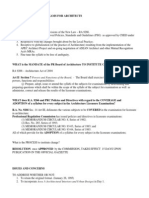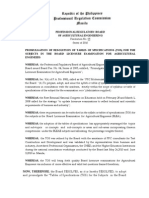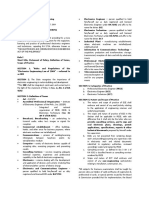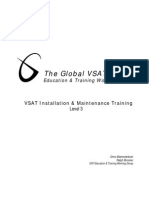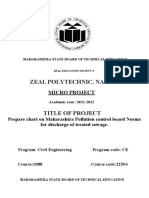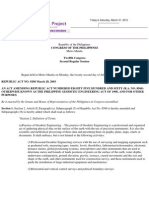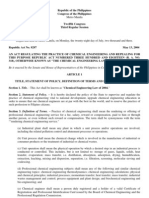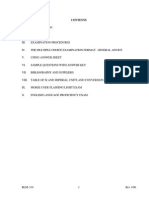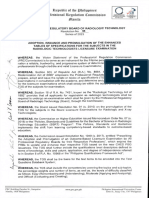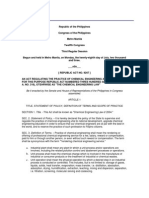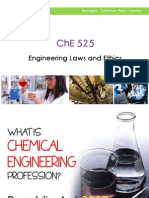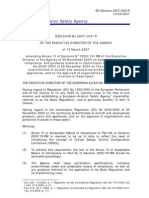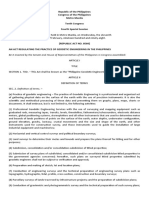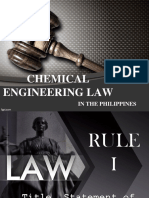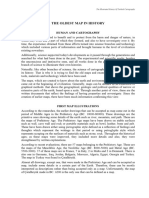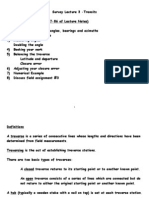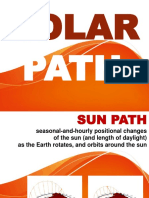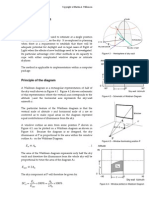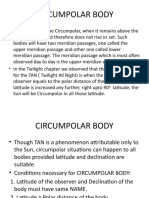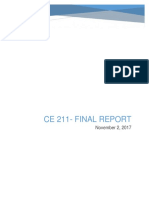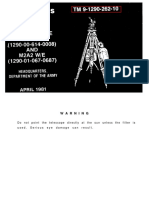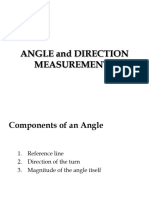PRC
PRC
Uploaded by
Jessie Radaza TutorCopyright:
Available Formats
PRC
PRC
Uploaded by
Jessie Radaza TutorOriginal Description:
Original Title
Copyright
Available Formats
Share this document
Did you find this document useful?
Is this content inappropriate?
Copyright:
Available Formats
PRC
PRC
Uploaded by
Jessie Radaza TutorCopyright:
Available Formats
Resolution No.
2004-211 NON-ADMISSION OF EXAMINEES ARRIVING LATE DURING THE CONDUCT OF LICENSURE EXAMINATIONS WHEREAS, Section 7 (d) of R.A. No. 8981, otherwise known as the PRC Modernization Act of 2000, empowers the Commission to administer and conduct the licensure examinations of the various regulatory boards in accordance with the rules and regulations promulgated by the Commission and to adopt measures to preserve the integrity and inviolability of licensure examinations. WHEREAS, there is a need to provide guidelines on the non-admission of examinees arriving late in order not to compromise the integrity of the licensure examinations. NOW, THEREFORE, pursuant further to Section 7 (d) of R. A. No. 8981, the Commission RESOLVED, as it hereby RESOLVES, to issue and promulgate the following guidelines on the nonadmission of examinees arriving late. 1. Under normal conditions, examinees arriving late after the start of the examinations shall NOT be allowed to take the examinations anymore. 2. In special cases such as high floods, typhoons, transport strike, threats to the peace and order situation like mass rally, mutiny, or coup de-tat, the start of the examinations shall be delayed and the time to finish or end shall be adjusted accordingly. The adjusted time to start and finish the examinations shall be the same in all test centers. Examinees arriving after the adjusted schedule shall no longer be allowed to take the examinations. 3. The Room Watchers shall indicate the time of arrival on the Examinees Record of Attendance Sheet for records purposes and indicate the remarks LATE - NOT ALLOWED TO TAKE EXAM. This Resolution shall take effect after fifteen (15) days following its official publication in the Official Gazette or in a newspaper of general circulation in the Philippines, whichever is earlier. Done in the City of Manila, this 12th day of May 2004.
(Signed) ANTONIETA FORTUNA-IBE Chairperson
(Signed) AVELINA A. DE LA REA Commissioner
(Signed) LEONOR TRIPON-ROSERO Commissioner
Resolution No. 02 Series of 1995 Promulgation of the Syllabi for the Subjects in the Civil Engineering Licensure Examination WHEREAS Sec. 10 Art II of R.A. No. 544: the Civil Engineering Law provides the subjects in the Civil Engineering Licensure Examination; WHEREAS the Commission has issued these policies and directives on licensure examinations: (1) memorandum Circular No. 8, Series of 1992, (2) Res. No. 265, Series of 1993, (3) Memorandum Circular No. 93-03, Series of 1993, and (4) Memorandum Circular No. 93-04, Series of 1993. WHEREAS every syllabus for the examination subject containing the concepts/topics, with the corresponding level of knowledge/proficiency shall be the basis for the test questions that will be inputted into the test question bank; and WHEREAS after consultation with the Department of Education, Culture, and Sports (DECS), the various schools/ colleges offering the civil engineering course, and the Philippine Institute of Civil Engineers (PICE), the board formulated its syllabi for the examination subjects. NOW, THEREFORE, by virtue of its quasi-legislative (rule-making) power under Sec. 4, Art. II of R.A. No. 544, the Board hereby RESOLVED, as it now so RESOLVES, to adopt and promulgate the syllabi for the subjects in the Civil Engineering Licensure Examination (Annex A). FURTHER, RESOLVED, that his resolution, upon approval by the Commission, shall be effective after fifteen (15) days following its publication in the Official Gazette or any newspaper of general circulation, whichever is earlier. FINALLY, RESOLVED, that this resolution be widely circularized and disseminated to all concerned through the DECS, the colleges offering the civil engineering courses, and the PICE. Done in the City of Manila this 28th day of February, 1995.
ERNESTO S. DE CASTRO Chairman MACRA A. CRUZ Member ALBERTO S. OLAN, SR. Member
Attested to: CARLOS G. ALMELOR Secretary, Regulatory Boards Approved: HERMOGENES P. POBRE Commissioner MARIANO A. MENDIETA Associate Commissioner
The Civil Engineering Licensure Examination Syllabi Section 4 of the Civil Engineering Law (Republic Act 544) provides among other things the power to the Board of Examinees for Civil Engineers to discharge such other powers and duties as may affect the ethical and technological standards of the Civil Engineering profession in the Philippines. Section 10 enumerates the subjects in which the applicants for certificates of registration shall be examined at the discretion of the Board; NOW THEREFORE, the Board of Civil Engineering, RESOLVED, as it hereby RESOLVES, that the licensure examinations for Civil Engineering shall be in accord with the following guidelines: I. Preparation of Examination Questions and Problems. The following shall be taken into consideration in the preparation of questions and problems: a. The areas covered by the examination shall be those included in the topics enumerated in the syllabus for the particular subject. The examination questions in each subject shall be comprehensive and well balanced in scope. b. Questions and answers should relate to matters which are of general applicability in the civil engineering practice in the Philippines. c. Questions and answers shall be framed in a clear and concise manner taking into consideration the degree or level of proficiency for each topic. Instructions or requirements should be clearly stated. d. The assigned weight and estimated time for each subject shall be indicated. Whenever applicable, references shall be made to statements issued by a. The Board of Civil Engineering b. The National Building Code of the Philippines c. The National Structural Code of the Philippines d. The National Standards Office e. The National Water Resources Council f. The Philippine Institute of Civil Engineers g. The Associate of Structural Engineers of the Philippines. In areas not covered by Philippine sources, references may also be made to the official pronouncement of authoritative standard setting agencies in the United States (ACI, ASCE, ASHTO, NSC, and UBC), International Building Officials (IBO), and the International Federation of Engineers (FIDIC) provided these pronouncements are relevant to Philippine conditions. e. Electronic and scientific calculators are allowed. However, programmable calculators and pocket personal computers are not allowed and will be confiscated if brought to the examination room.
II. Subjects of Examinations Unless otherwise indicated, the topics of the subjects shall be effective in the May 1993 Licensure Examinations. The Syllabi shall be fully effective starting on the May 1994 examinations. A. MATHEMATICS AND SURVEYING Mathematics 1.0 Algebra 1.1 Set Theory* 1.2 Real Numbers 1.3 Algebraic Expressions and Operations 1.4 Equations and Inequalities 1.5 Roots and Powers 1.6 Linear, Quadratic and Polynomial Functions 1.7 Factoring 1.8 Roots of Algebraic Equations 1.9 System of Equations 1.10Logarithmic and Exponential Functions 1.11Arithmetic and Geometric Progressions 2.0 Trigonometry 2.1 Circular (Trigonometric) Functions 2.2 Trigonometric Identities and Equations 2.3 Solution of Triangles 2.4 Hyperbolic Functions 3.0 Analytic Geometry 3.1 Cartesian Coordinate System 3.2 Functions and Relations 3.3 Functions and their Graphs 3.4 Straight lines 3.5 Conic Sections 3.6 Polar Coordinates 3.7 Transformation of Coordinates 3.8 Parametric Equations 4.0 Calculus 4.1 Differential Equations 4.1.1 Limits and Continuity 4.1.2 Derivatives and Differentiation 4.1.3 Application of Derivatives 4.1.4 The Differential 4.1.5 Partial Derivatives 4.2 Integral Calculus 4.2.1 Theory of Integrals 4.2.2 Integration Methods 4.2.3 Definite Integrals and Applications 4.2.4 Line and Surface Integrals 4.2.5 Multiple Integrals 5.0 Differential Equations 5.1 First Order Differential Equation 5.1.1 Exact Differential Equation 5.1.2 Integrating Factors** 5.1.3 Separable Variables 5.1.4 Homogeneous Differential Equations 5.1.5 Linear Differential Equations 5.1.6 Applications 5.2 Higher Order Differential Equations 6.0 Other Topics 6.1 Infinite Series 6.1.1 Maclaurin Series 6.1.2 Taylor Series 6.1.3 Fourier Series 6.2 Complex Variables** 6.3 Vector Analysis 6.4 Matrices* 6.5 Determinants* 6.6 Probability and Statistics 7.0 Engineering Economy 7.1 Present Economy Study 7.2 Time-Value Relations 7.3 Selection Among Alternatives 7.3.1 Present Worth Method 7.3.2 Annual Worth Method 7.3.3 Future Worth Method 7.3.4 Internal Rate of Return Method 7.3.5 External Rate of Return Method
Surveying 1.0 Surveying Concepts 1.1 Uses of Surveys 1.2 Operations in Surveying 1.3 Measurement and Adjustments 1.4 Field and Office Work 1.5 Surveying Instruments 2.0 Basic Surveying Measurements 2.1 Distance Measurements 2.1.1 Pacing 2.1.2 Distance Measurement with Tape 2.2 Vertical Distance Measurement; Leveling 2.3 Angle and Direction Measurement 2.3.1 Location of Points 2.3.2 Meridians 2.3.3 Bearing and Azimuth 2.3.4 Magnetic Declination 2.3.5 Instruments Used 2.3.5.1 Engineers Transit 2.3.5.2 Theodolite 2.4 Stadia and Tacheometry 2.4.1 Principles of Stadia 2.4.2 Plane Table and Alidade 3.0 Survey Operations 3.1 Traverse 3.1.1 Deflection Angle Traverse 3.1.2 Interior Angle Traverse 3.1.3 Traverse by Angle to the Right 3.1.4 Azimuth Traverse 3.1.5 Compass Traverse 3.1.6 Stadia Traverse 3.1.7 Plane Table Traverse 3.2 Calculation of Areas of Land 3.2.1 Area by Triangle 3.2.2 Area by Coordinates 3.2.3 Area by Double Meridian Distance (DMD) and Latitude 3.2.4 Irregular Boundaries (Simpsons and Trapezoidal Rules) 3.3 Triangulation and Trilateralization 3.3.1 Horizontal Control System 3.3.2 Triangulation Figures and Procedures 3.3.3 Error Propagation 3.3.4 Trilateralization 3.4 Astronomical Observation 3.4.1 Celestial Sphere 3.4.2 Equator System 3.4.3 The PZS Triangle 3.4.4 Azimuth and Hour Angle at Elongation 3.4.5 Time 3.4.6 Solar Observation 3.4.7 Stellar Observation 4.0 Engineering Surveys 4.1 Topographic Survey 4.1.1 Horizontal Control 4.1.2 Vertical Control (contours) 4.1.3 Location of Details 4.2 Route Surveying 4.2.1 Horizontal Curves 4.2.1.1 Simple Curves 4.2.1.2 Compound Curves 4.2.1.3 Superelevations 4.2.1.4 Spiral Curves 4.2.2 Vertical Curves 4.2.3 Earthwork Operations 4.2.3.1 Methods of Determining Earthwork Volumes 4.2.3.2 Borrow Pits 4.3 Hydrographic Surveys 4.3.1 Datum 4.3.2 Soundings
B. HYDRAULICS 1.0 Fluid Mechanics 1.1 Properties of Fluids 1.2 Fluid Statics 1.3 Fluid Flow Concepts and Basic Equations 1.4 Dimensionally Analysis and Dynamic Similitude 1.5 Viscous Flow and Fluid Resistance 1.6 Ideal Fluid Flow 1.7 Steady Flow in Closed Conduits 1.8 Steady Flow in Open Channels 2.0 Hydrology 2.1 Hydrologic Cycle 2.1.1 Precipitation 2.1.2 Stream-flow 2.1.3 Evaporation 2.1.4 Transpiration 2.2 Hydrograph Analysis 2.2.1 Runoff 2.2.2 Storage Routing 2.3 Groundwater 3.0 Hydraulics, System and Structure 3.1 Reservoirs 3.2 Dams 3.3 Spillways, Gates, and Outlet Works 3.4 Open Channels 3.5 Pressure Conduits 3.6 Hydraulics Machinery 4.0 Irrigation, Flood Control and Drainage 4.1 Irrigation 4.1.1 Water Requirement 4.1.2 Soil-Water Relation 4.1.3 Water Quality 4.1.4 Methods 4.1.5 Structures 4.2 Flood Control 4.2.1 Design Flood 4.2.2 Flood Control Structures 4.3 Drainage 4.3.1 Estimate of Flow 4.3.2 Storm Drainage 4.3.3 Land and Highway Drainage 4.3.4 Culverts and Bridges 4.3.5 Drainage Structures
5.0 Water Supply and Sewerage 5.1 Fundamental Concept 5.1.1 Mathematics of Growth (Population Forecasting) 5.1.2 Environmental Chemistry 5.1.3 Mass and Energy Transfer 5.2 Water Supply and Treatment 5.2.1 Components of Water Supply System 5.2.1.1 Water Reservoir and Storage 5.2.1.2 Water Distribution System 5.2.1.3 Water Containment Structures 5.2.2 Water Consumptions Periods of Design 5.2.3 Pre-treatment Methods 5.2.4 Principles of Sedimentation 5.2.5 Sedimentation Tank Design 5.2.6 Coagulation-Sedimentation 5.2.7 Slow Sand Filtration 5.2.8 Rapid Sand Filtration 5.2.9 The Rapid Sand Filter 5.2.10 Underdrain System 5.2.11 Wash Troughs 5.2.12 The Washing Process 5.2.13 Clear Well and Plant Capacity 5.2.14 Water Disinfection 5.3 Waste Water Treatment 5.3.1 Quantity 5.3.2 Methods 5.3.3 Theory of Activated Sludge 5.3.4 Aeration Tank 5.3.5 Biokinetic Parameters* 5.3.6 Clarifiers
C. DESIGN AND CONSTRUCTION 1.0 Statics of Rigid Bodies 1.1 Force System 1.1.1 Concurrent and Non-current Force System 1.1.2 Parallel and Non-parallel Force System 1.1.3 Planar and Three Dimensional Force System 1.1.4 Distributed Forces 1.1.5 Frictional Forces 1.2 Equilibrium of Forces 1.2.1 Reactions 1.2.2 Free Body Diagram 1.2.3 Two Force Bodies 1.2.4 Three Force Bodies 1.3 Truss Analysis 1.3.1 Method of Joints 1.3.2 Method of Sections 1.3.3 Graphical Methods 1.4 Beams and Frames 1.4.1 Reactions 1.4.2 Shear Diagrams 1.4.3 Bending Moment Diagrams 1.5 Related Topics 1.5.1 Moment of Lines and Areas 1.5.2 Centroids 1.5.3 Moments of Inertia 1.5.4 Center of Mass 1.5.5 Center of Forces 2.0 Dynamics of Rigid Bodies 2.1 Kinematics of Particles 2.1.1 Rectilinear Motion 2.1.2 Curvilinear Motion 2.2 Kinetics of Particles 2.2.1 Newtons Second Law 2.2.2 Dynamic Equilibrium 2.2.3 Work and Energy Principle 2.2.4 Kinetic and Potential Energy 2.2.5 Impulse and Momentum Principle 2.3 Kinematics of Rigid Bodies 2.3.1 Translation 2.3.2 Rotation 2.3.3 General Plane Motion 2.4 Kinetics of Rigid Bodies 2.4.1 D' Alembert's Principle 2.4.2 Work and Energy Principle 2.4.3 Impulse and Momentum Principle 3.0 Mechanics 3.1 Stresses and Strains 3.2 Material Properties 3.3 Axially Loaded Members 3.4 Thin Walled Pressure Vessels 3.5 Torsional Stresses 3.6 Internal Forces and Stresses in Beams 3.6.1 Flexural Stress 3.6.2 Shear Stress 3.6.3 Combined Stresses 3.6.4 Principal Stresses 3.6.5 Unsymmetrical Banding 3.7 Deflections 3.7.1 Double Integration Methods 3.7.2 Area Moment Method 3.7.3 Conjugate Beam Method 3.8 Statistically Indeterminate Beams 3.9 Shear Center 3.10 Curved Beams 3.11 Non-homogenous Beams 3.12 Impact Loading 3.13 Stress Concentration 3.14 Repeated Loading 3.15 Elastic Instability (Buckling) 3.16 Analysis of Connections 3.16.1 Riveted and Bolted Connections 3.16.2 Welded 4.0 Structural Analysis 4.1 Loadings 4.1.1 Vertical Loads (dead and live loads) 4.1.2 Lateral Loads (Wind and Earthquake Loads) 4.1.3 Impact Loads 4.2 Energy Methods for Deformation Analysis 4.2.1 Castigliano's Theorem 4.2.2 Virtual Work Method (Unit Load) 4.3 Influence Lines 4.4 Frame Analysis 4.4.1 Approximate Methods 4.4.2 Exact Methods* 4.4.3 Moment Distribution 4.5 Stiffness and Flexibility Methods of Analysis** 4.5.1 Trusses 4.5.2 Beams
4.5.3 Frames 5.0 Design of Timber Structures 5.1 Properties of Wood 5.2 Design of Tension Member 5.3 Design of Bending Members 5.3.1 Laterally Supported Beams 5.3.2 Laterally Unsupported Beams 5.4 Design of Compression Members 5.4.1 Short Columns 5.4.2 Slender Columns 5.4.3 Spaced Columns 5.5 Timber Connections 6.0 Design of Steel Structures 6.1 General 6.1.1 Properties of Structural Steel 6.1.2 Design Philosophy 6.1.2.1 Allowable Stress Design 6.1.2.2 Load and Resistance Factor Design 6.2 Tension Members 6.3 Connections 6.3.1 Bolted 6.3.2 Welded 6.4 Compression Members 6.5 Beams 6.5.1 Compact Sections 6.5.2 Non-compact Sections 6.6 Beam Columns 6.7 Plastic Analysis and Limit Design* 6.8 Composite Steel and Concrete 7.0 Reinforced Concrete Structures 7.1 General 7.1.1 Properties of Concrete Materials 7.1.2 Design Philosophies and Procedures 7.2 Flexural Analysis and Design 7.3 Shear and Diagonal Tension 7.4 Bond, Anchorage Development Lengths 7.5 Serviceability Requirements 7.5.1 Crack Control 7.5.2 Deflections 7.6 Columns 7.6.1 Short Columns 7.6.2 Slender Columns 7.7 Slabs 7.8 Footings 7.9 Retaining Wall
7.10 Pre-stressed Concrete 8.0 Soil Mechanics and Foundation 8.1 Soil Properties 8.2 Soil Classification 8.3 Flow of Water in Soils 8.3.1 Permeability 8.3.2 Seepage 8.3.3 Effective and Porewater Pressure 8.4 Soil Strength 8.4.1 Shear Strength 8.4.2 Bearing Capacity 8.5 Compressibility of Soils 8.5.1 Elastic Settlement 8.5.2 Consolidation Settlement 8.6 Soil Improvement 8.6.1 Compaction 8.6.2 Soil Stabilization 8.7 Earth Pressures and Retaining Wall 8.8 Slope Stability Analysis 9.0 Design of Civil Engineering Structures and Systems 9.1 Transportation Engineering** 9.1.1 Highway and Urban Transportation Planning and Economics** 9.1.2 Driver, Vehicle, Traffic and Road Characteristics** 9.1.3 Highway Design 9.1.4 Traffic Engineering and Highway Operations** 9.1.5 Road and Pavement Design 9.2 Airport Engineering** 9.3 Ports and Harbors 9.4 Containment Structures (Tanks, soils, storage tanks) 9.5 Bridges 10.0 Construction and Management 10.1 Engineering Relations and Ethics** 10.2 Contracts & Specifications 10.3 Construction Project Organization 10.4 Planning and Scheduling (PERT/CPM) 10.5 Construction Estimates 10.6 Construction Methods & Operations 10.7 Construction Equipment Operations and Maintenance
III. CONDUCT OF THE EXAMINATIONS Unless otherwise officially announced, the examinations shall be totally computerized. The Board shall provide a minimum of 500 questions for each subject from which the computer of the Commission will select at random on the day or a few days prior to the examination the questions to be given. The number of questions for each subject shall not be less than 20 at 4 points each. The maximum number of questions shall not be more than 100 at 1 point each. The examination shall be closed books and notes. Examinees shall be given 10 computation and scratch sheets which must be submitted with the answer sheets. IV. CHANGES IN THE SYLLABI The Syllabi can be changed from time to time only with the introduction of the new methods and technology in civil engineering but not more than once every three years. Code of Ethics It shall be considered unprofessional and inconsistent with honorable and dignified bearing for any registered Civil Engineer: To act for his clients* in professional matters otherwise than as a faithful agent or trustee, or to accept any remuneration other than his stated charges for services rendered his clients. To attempt to injure falsely or maliciously, directly or indirectly, the professional reputation, prospects, or business of another Engineer. To attempt to supplant another Engineer after definite steps have been taken toward his employment. To participate in competitive bidding on a price basis to secure a professional engagement. To compete with another Engineer for employment on the basis of professional charges, by reducing his usual charges and in this manner attempting to underbid after being informed of the charges named by another. To review the work of another Engineer for the same client, except with the knowledge or consent of such Engineer, or unless the connection of such Engineer with the work has been terminated. To advertise in self-laudatory language, or in any other manner derogatory to the dignity of the Profession. To use the advantages of a salaried position to compete unfairly with Engineers in private practice. To act in any manner or engage in any practice which will tend to bring discredit on the honor or dignity of the Engineering Profession. *The word clients is considered to be inclusive of the meaning of the word employers.
You might also like
- E-Ticket Itinerary/Receipt 12074713Document8 pagesE-Ticket Itinerary/Receipt 12074713Jessie Radaza Tutor100% (2)
- Architecture Board Exam Syllabus in The PhilippinesDocument15 pagesArchitecture Board Exam Syllabus in The PhilippinesGwen Harriet Bautista100% (2)
- RLM319Document29 pagesRLM319satyabrat gaanNo ratings yet
- Philippine Mechanical Engineering Act of 1998Document27 pagesPhilippine Mechanical Engineering Act of 1998EdrielleNo ratings yet
- Table of Specification For AE Licensure ExamDocument9 pagesTable of Specification For AE Licensure ExamsorianomarkjayNo ratings yet
- RA 9292 SummaryDocument7 pagesRA 9292 SummaryRayland Angelo Torres100% (2)
- GVF VSAT Install and Maint Handbook Level 3 Rev1 31 OBDocument51 pagesGVF VSAT Install and Maint Handbook Level 3 Rev1 31 OBHippolyte Evouna100% (3)
- Board of Civil Engineering-SyllabusDocument8 pagesBoard of Civil Engineering-SyllabusAndrei AlidoNo ratings yet
- The Scope Ce BoardDocument13 pagesThe Scope Ce BoardeleonorNo ratings yet
- Board of Civil Engineering Exam ScopeDocument8 pagesBoard of Civil Engineering Exam ScopeMANDARAW93% (14)
- Compilation of ReportsDocument139 pagesCompilation of ReportsKim Valencia PobleteNo ratings yet
- The Civil Engineering Licensure Examination SyllabiDocument9 pagesThe Civil Engineering Licensure Examination Syllabiapi-281795875No ratings yet
- Civil Engineering Licensure Examination, PD 1096Document138 pagesCivil Engineering Licensure Examination, PD 1096lanyNo ratings yet
- Public Health EngineeringDocument10 pagesPublic Health EngineeringOmkar DeshpandeNo ratings yet
- Be It Enacted by The Senate and House of Representatives of The Philippines in Congress AssembledDocument6 pagesBe It Enacted by The Senate and House of Representatives of The Philippines in Congress AssembledYohan San PedroNo ratings yet
- R.A. 9297 New ChE LawDocument10 pagesR.A. 9297 New ChE LawRexel ReedusNo ratings yet
- Link Click DB 80Document50 pagesLink Click DB 80scha_linaNo ratings yet
- ChE 555 Code of EthicsDocument45 pagesChE 555 Code of EthicsjestlejNo ratings yet
- Board of Civil Engineering-SBDocument5 pagesBoard of Civil Engineering-SBJingNo ratings yet
- Ra 9297Document7 pagesRa 9297Daphne Cosi LealNo ratings yet
- Certificate of Competency Examinations 1970 PDFDocument21 pagesCertificate of Competency Examinations 1970 PDFVan PijeNo ratings yet
- Republic Act No. 9200Document16 pagesRepublic Act No. 9200Jhara Hamoy0% (1)
- M and e Induction CourseDocument10 pagesM and e Induction CourseTiffany CombsNo ratings yet
- Geodetic Engineering Laws, Obligations and ContractsDocument79 pagesGeodetic Engineering Laws, Obligations and Contractsalleyah.veronicaNo ratings yet
- Republic ActDocument8 pagesRepublic ActJohn Emmanuel DimayugaNo ratings yet
- 2E RSP Study 3 OBD Part1Document47 pages2E RSP Study 3 OBD Part1Kunal AhiwaleNo ratings yet
- Republic Act No. 8495 (Me Law) - Part 1Document115 pagesRepublic Act No. 8495 (Me Law) - Part 1Ray charles De Vera100% (1)
- Bis 15054-2001Document75 pagesBis 15054-2001drjonesg19585102No ratings yet
- Be It Enacted by The Senate and House of Representatives of The Philippine Congress AssembledDocument6 pagesBe It Enacted by The Senate and House of Representatives of The Philippine Congress AssembledDinah Jane MartinezNo ratings yet
- Geodetic Engineering Law PDFDocument6 pagesGeodetic Engineering Law PDFmarting69100% (2)
- Mechanical Engineering ReviewerDocument13 pagesMechanical Engineering ReviewerAllen Reyes100% (1)
- Exams For Sea Fareres PDFDocument35 pagesExams For Sea Fareres PDFSamir Alshaar100% (2)
- Ra 9297Document9 pagesRa 9297paomillan0423No ratings yet
- New Tos For December 2023 Rtle 120246Document33 pagesNew Tos For December 2023 Rtle 120246Shawn Timothy ClemeñaNo ratings yet
- ACEM M&E Course Flyer 2017Document9 pagesACEM M&E Course Flyer 2017munim87No ratings yet
- Chemical Engineering LawDocument8 pagesChemical Engineering Lawdecember8No ratings yet
- Review - Republic Act No. 8981Document37 pagesReview - Republic Act No. 8981iloilocityNo ratings yet
- University of Calicut (Abstract) : Contd ..2Document44 pagesUniversity of Calicut (Abstract) : Contd ..2Nbisht25No ratings yet
- Me 421 Module 1Document32 pagesMe 421 Module 1I AM CHESCA (IamChesca)No ratings yet
- Chemical Engineering Law Ra 9297 ReportDocument32 pagesChemical Engineering Law Ra 9297 ReportGeofrey Sy BajeNo ratings yet
- Overseas Road Note 2Document49 pagesOverseas Road Note 2Iftikhar Kamran83% (6)
- MELAWSMANUALDocument142 pagesMELAWSMANUALEasy Write0% (1)
- 2007-003-R Fuel Tank Safety Part-66Document6 pages2007-003-R Fuel Tank Safety Part-66Sridhar ChelliboyanaNo ratings yet
- CS Course Flyer May2015Document8 pagesCS Course Flyer May2015orgaNo ratings yet
- Republic Act No 7920Document17 pagesRepublic Act No 7920Drofer ConcepcionNo ratings yet
- Sug 208-Enginering TextbookDocument65 pagesSug 208-Enginering TextbookJoshua OluwadamilareNo ratings yet
- Model Rules 2014Document43 pagesModel Rules 2014TuroyNo ratings yet
- Republic of The Philippines Congress of The Philippines Metro Manila Tenth Congress Fourth Special SessionDocument7 pagesRepublic of The Philippines Congress of The Philippines Metro Manila Tenth Congress Fourth Special SessionChrystia CampitNo ratings yet
- CHE EthicsDocument124 pagesCHE EthicsZim MojaresNo ratings yet
- International Electrotechnical CommissionDocument24 pagesInternational Electrotechnical CommissionAngel DaniellaNo ratings yet
- Operations and Production Systems with Multiple ObjectivesFrom EverandOperations and Production Systems with Multiple ObjectivesNo ratings yet
- Applied Metrology for Manufacturing EngineeringFrom EverandApplied Metrology for Manufacturing EngineeringRating: 5 out of 5 stars5/5 (1)
- Real-Time Systems: Scheduling, Analysis, and VerificationFrom EverandReal-Time Systems: Scheduling, Analysis, and VerificationNo ratings yet
- Optical Payloads for Space MissionsFrom EverandOptical Payloads for Space MissionsShen-En QianNo ratings yet
- Vibration-based Condition Monitoring: Industrial, Aerospace and Automotive ApplicationsFrom EverandVibration-based Condition Monitoring: Industrial, Aerospace and Automotive ApplicationsNo ratings yet
- ASPHALTDocument7 pagesASPHALTJessie Radaza TutorNo ratings yet
- TOEIC-style Error Recognition: 23130 Page 1 of 2Document2 pagesTOEIC-style Error Recognition: 23130 Page 1 of 2Jessie Radaza TutorNo ratings yet
- Balili River Polygon 177 56.5568 48.6741: Name Shape Type of Points S) RS)Document3 pagesBalili River Polygon 177 56.5568 48.6741: Name Shape Type of Points S) RS)Jessie Radaza TutorNo ratings yet
- Generational Differences in Acute Care NursesDocument13 pagesGenerational Differences in Acute Care NursesJessie Radaza TutorNo ratings yet
- New Dicklumn Catchment Area Polygon 43 3,513.9229 17.3662: Name Shape Type of Points (Acres) (Miles)Document3 pagesNew Dicklumn Catchment Area Polygon 43 3,513.9229 17.3662: Name Shape Type of Points (Acres) (Miles)Jessie Radaza TutorNo ratings yet
- New Dicklumn Catchment Area Polygon 43 14.2203 27.9481: Name Shape Type of Points S) RS)Document3 pagesNew Dicklumn Catchment Area Polygon 43 14.2203 27.9481: Name Shape Type of Points S) RS)Jessie Radaza TutorNo ratings yet
- Origin and Theoretical Basis of The New Public Management (NPM)Document35 pagesOrigin and Theoretical Basis of The New Public Management (NPM)Jessie Radaza TutorNo ratings yet
- Syllabus Public Management ReformsDocument3 pagesSyllabus Public Management ReformsJessie Radaza TutorNo ratings yet
- Engr. Jessie Radaza Tutor: Personal InformationDocument4 pagesEngr. Jessie Radaza Tutor: Personal InformationJessie Radaza TutorNo ratings yet
- Staad LectureDocument3 pagesStaad LectureJesus Ray M. Mansayon100% (3)
- Structural Analysis ExamDocument3 pagesStructural Analysis ExamJessie Radaza TutorNo ratings yet
- Easy Investment Program GuideDocument8 pagesEasy Investment Program GuideaprilbiluganNo ratings yet
- JDS Math2013 SolutionDocument5 pagesJDS Math2013 SolutionJessie Radaza Tutor100% (3)
- BureaucracyDocument23 pagesBureaucracyAbdillah Abdul-rahmanNo ratings yet
- REvised - Assignment of Topic Presentation For Quantitative Approaches in ManagementDocument1 pageREvised - Assignment of Topic Presentation For Quantitative Approaches in ManagementJessie Radaza TutorNo ratings yet
- Philippine Journal of Public AdministrationDocument18 pagesPhilippine Journal of Public AdministrationJessie Radaza Tutor0% (1)
- Table of ContentsDocument1 pageTable of ContentsJessie Radaza TutorNo ratings yet
- President of The Philippines: QualificationsDocument20 pagesPresident of The Philippines: QualificationsJessie Radaza TutorNo ratings yet
- CESURV30 W9 Lec6 - Compass Surveying - For White Board - 052625Document34 pagesCESURV30 W9 Lec6 - Compass Surveying - For White Board - 052625Gabriela Jubell ManabatNo ratings yet
- Exp-2 Aim-To Study Antenna Look Angles Using Octave Software-Octave TheoryDocument6 pagesExp-2 Aim-To Study Antenna Look Angles Using Octave Software-Octave TheoryMansi Kolwankar KokateNo ratings yet
- History of Turkish CartographyDocument147 pagesHistory of Turkish CartographyPelin Akten100% (2)
- Bearing and Distance Calculation MethodsDocument6 pagesBearing and Distance Calculation MethodsDayat Hidayat HidayatNo ratings yet
- Technical: Nasa TNDocument36 pagesTechnical: Nasa TNMatt GrahamNo ratings yet
- Lecture 3Document28 pagesLecture 3Lovely ZahraNo ratings yet
- Total Station PDFDocument19 pagesTotal Station PDFnirupadi9535No ratings yet
- Celestial Navigation BasicsDocument6 pagesCelestial Navigation Basicsmsk5in100% (1)
- Suveying Mid Term Exam PDFDocument6 pagesSuveying Mid Term Exam PDFRohit KumarNo ratings yet
- HeliotropeDocument19 pagesHeliotropeAndreaMaranoNo ratings yet
- SAC User ManualDocument19 pagesSAC User ManualHoàng HảiNo ratings yet
- Total StationDocument62 pagesTotal StationRifa TasfiaNo ratings yet
- Length NMDCDocument8 pagesLength NMDCAlish SBNo ratings yet
- Solar Path Midterm QuizDocument23 pagesSolar Path Midterm QuizAmabelle SantosNo ratings yet
- Waldram C - 4Document6 pagesWaldram C - 4warrenronald100% (1)
- Field Work No. 6 Azimuth Traverse: Mapúa Institute of TechnologyDocument14 pagesField Work No. 6 Azimuth Traverse: Mapúa Institute of TechnologyPatrickTulayNo ratings yet
- Circumpolar BodyDocument42 pagesCircumpolar BodyDevanshu SharmaNo ratings yet
- Survey - 6 - Angle 2023Document16 pagesSurvey - 6 - Angle 2023e64095346No ratings yet
- Using The Astro-Compass To Study Solar AccessDocument7 pagesUsing The Astro-Compass To Study Solar AccesslaeionNo ratings yet
- Ch-6 1Document31 pagesCh-6 1Parwiz YosofiNo ratings yet
- Traverse LabDocument15 pagesTraverse LabBesufkad YirguNo ratings yet
- Lecture #2: Uzair@neduet - Edu.pkDocument63 pagesLecture #2: Uzair@neduet - Edu.pkabdullah ibraheemNo ratings yet
- Surveying Lab ReportDocument14 pagesSurveying Lab Reportapi-385520144No ratings yet
- TM-9-1290-262-10 Aiming CircleDocument95 pagesTM-9-1290-262-10 Aiming CircleHari IswantoNo ratings yet
- OBTL Form 3 CE 2101 Lec Course Syllabus 2019Document6 pagesOBTL Form 3 CE 2101 Lec Course Syllabus 2019mark floresNo ratings yet
- Lecture 7 - Angle and Direction MeasurementDocument28 pagesLecture 7 - Angle and Direction Measurementpeterpaul_1211No ratings yet
- The Celestial SphereDocument5 pagesThe Celestial Spheredennis77No ratings yet
- VT State Plane: Daniel J. Martin National Geodetic Survey VT Geodetic AdvisorDocument49 pagesVT State Plane: Daniel J. Martin National Geodetic Survey VT Geodetic AdvisorIonut Alexandru CristeaNo ratings yet
- Celestial Coordinate SystemsDocument25 pagesCelestial Coordinate SystemsElisha ManishimweNo ratings yet

